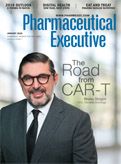CAR-T Concerns for Continued Success
Pharmaceutical Executive
The advent of immunocellular therapies marks a major milestone in pharma, but the path for these treatments in transforming patient care is still forming as they face challenges in clinical trials, pricing, and market acceptance,
for 2018 Trends, both Editorial Advisory Boards (Pharmaceutical Executive and Applied Clinical Trials) named CAR-T and gene therapy. Ultimately, we chose eight trends to explore in this year’s industry outlook, and CAR-T was not on that list. We felt that 2018 is only the beginning of CAR-T therapy development, and the challenges around that will exist for a few years. Those challenges include clinical trials, pricing, and market acceptance. To provide first-hand insight, we were fortunate to have our editorial partner PharmaBoardroom
Lisa Henderson

interview Bruno Strigini, the departing CEO of Novartis Oncology, in October. That interview describes the path to bringing the first FDA-approved immunocellular therapy with Kymriah, for B-cell precursor ALL, to market.
As noted in the annual pipeline report in November, both Kymriah and Kite’s Yescarta for NHL were approved by the FDA in 2017. But also that CAR-T is a powerful and risky therapy and drug companies are responding to some of the more worrisome side effects. The FDA recently approved Genentech’s tocilizumab (Actemra) to treat severe cytokine release syndrome (CRS), a potentially deadly side effect to CAR-T therapies.
In fact, as Aaron Mitchell, a managing principal at ZS Associates, noted in an email to me, CRS is “the most common adverse event patients are facing in the trials, with 81% of patients in Novartis studies B2202 and B2205J experiencing some form of CRS, with about 45% experiencing Grade 3 or 4.” Mitchell said that CRS symptoms can be quite severe and extensive, especially in patients with a high tumor burden. He added that to prevent and manage CRS in CAR-T patients, “companies have implemented rigorous CRS management protocols. For example, Novartis worked with the University of Pennsylvania on its algorithm, which includes multiple lines of treatment to resolve CRS once it appears.”
Clinical trial challenges
Because clinical trials are designed to test a completely new treatment paradigm (genetically modified autologous immunocellular therapy), it is significantly different from typical pharmaceutical therapies. For that reason, Mitchell says that many of the standard processes around currently established manufacturing, fulfillment, and treatment have been redesigned to support CAR-T development.
Mitchell said, “The manufacturing process itself is quite complicated in that you are dealing with a highly variable input from each patient and you need to develop a consistent final product. This makes developing a reproducible manufacturing process quite difficult. For Novartis, they have made significant investment in a single site in Morris Plains, NJ, for nearly all their patients in pivotal trials.”
Pricing and acceptance
Strigini says in his interview that Novartis put a lot of thought into pricing Kymriah, using standard of care pricing of a bone marrow transplant, as well as independent evaluations, including those from NICE. Kymriah is priced at $475,000 for a one-time treatment, and Novartis is offering value-based pricing, whereby insurers will only pay for patients who go into remission within three months of receiving the therapy. Yescarta is priced at $373,000, offers financial help for patients, but does not offer a value-based pricing scheme.
In December, Cardinal Health released the results of a survey of 200 oncologists conducted to “better understand their perceptions about CAR-T and the potential barriers to adoption (view here).” The results found that the top three barriers to prescribing CAR-T cell therapy were as follows: logistics of administering and following patients are cumbersome (59%); cost of therapy (44%); and toxicity is too high (35%).
Since CAR-T cell therapies must be administered in the hospital or at an accredited center, gaining community oncologist support is crucial, as illustrated in the Cardinal report, which noted that 31% of oncologists were referring AML patients to academic centers for treatment.
ICON addressed these concerns in an article that appeared in December and provides a list of key factors to help ensure market access. These include continuing to follow patients after the trial closes; engage treatment centers early in the process; develop and share data on the burden of disease; and more.
As these new therapies enter the “traditional” world of pharma, trials, pricing, and acceptance will evolve with time and experience. As Mitchell noted: “Over time, further standardization will happen, allowing these trials to happen more quickly and efficiently and at a global scale. In the meantime, strong partnerships between sponsors, sites/investigators, and regulators is needed to support these trials as well as develop the necessary processes and capabilities.”
Lisa Henderson is Editor-in-Chief of Pharm Exec. She can be reached at lisa.henderson@ubm.com. Follow Lisa on Twitter: @trialsonline

FDA Grants Priority Review to Regeneron’s Eylea for Macular Edema Following Retinal Vein Occlusion
April 18th 2025Regulatory action was based on data from the Phase III QUASAR trial, which demonstrated that Eylea HD dosed every eight weeks achieved non-inferior visual acuity outcomes compared to Eylea in patients with macular edema following retinal vein occlusion.
Addressing Disparities in Psoriasis Trials: Takeda's Strategies for Inclusivity in Clinical Research
April 14th 2025LaShell Robinson, Head of Global Feasibility and Trial Equity at Takeda, speaks about the company's strategies to engage patients in underrepresented populations in its phase III psoriasis trials.
New Insights Into T Cell Exhaustion and Inflammation in Long COVID
April 17th 2025Nigel McCracken, chief operating officer, Virax Biolabs, discusses new findings that reveal altered cytokine activity and evidence of T cell exhaustion in long COVID patients, providing deeper insight into post-infection immune disruption.
Key Findings of the NIAGARA and HIMALAYA Trials
November 8th 2024In this episode of the Pharmaceutical Executive podcast, Shubh Goel, head of immuno-oncology, gastrointestinal tumors, US oncology business unit, AstraZeneca, discusses the findings of the NIAGARA trial in bladder cancer and the significance of the five-year overall survival data from the HIMALAYA trial, particularly the long-term efficacy of the STRIDE regimen for unresectable liver cancer.
Amgen’s Imdelltra Demonstrates Significant Overall Survival Improvement in Small Cell Lung Cancer
April 16th 2025In the Phase III DeLLphi-304 trial, patients with small cell lung cancer administered Imdelltra achieved a statistically significant and clinically meaningful improvement in overall survival compared to standard-of-care chemotherapy.